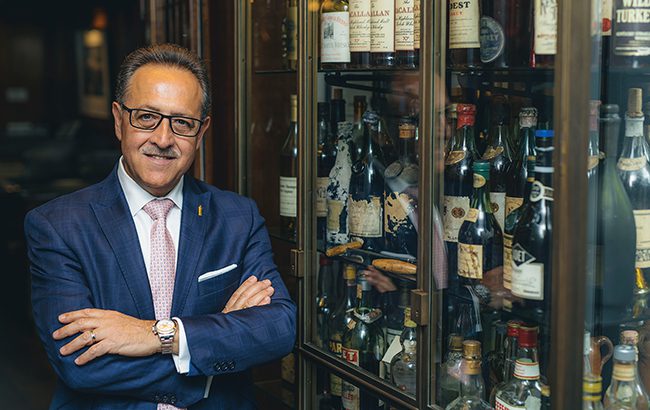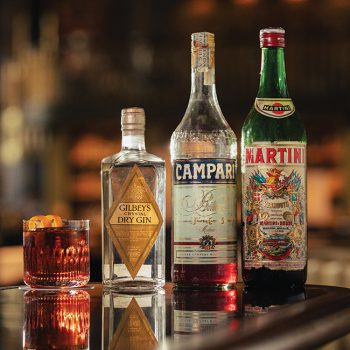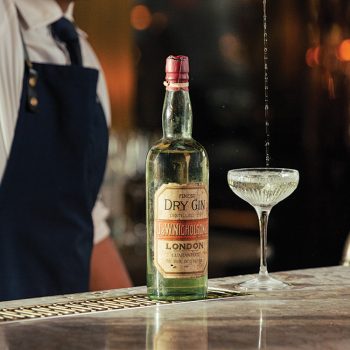Old school: why vintage spirits are the new trend
Cocktails made with vintage spirits are sought after and bartenders love the challenge of hunting down bottles. We speak to the experts about the challenges of finding rare liquids and creating serves from them.

*This feature was originally published in the August 2023 issue of The Spirits Business magazine.
In the world of spirits, age isn’t just a number. Time is one of the most valuable ingredients any spirit can wish to possess, and more so now than ever. Bartenders around the world are making the most of the commodity on their menus in the form of vintage cocktails.
If you’ve ever visited a high-end bar, there is a chance you have stumbled across this genre of cocktails. You’ll know if you have, because it’s likely the price made you baulk. “£350 for a cocktail? Oh, I’ll have two,” you may have joked. But often, the rarity of the spirits used in these vintage serves more than justifies the eye-popping price tag, Lidiyanah ‘Yana’ K, head bartender of Singapore’s Atlas bar, says. “The bottles we use are expensive, and the older it is, the more expensive it is,” she says. She recently bought a bottle of 1930s gin for €900 (US$994).
However, Yana tells me she struggles with pricing her serves – constantly searching for the ‘sweet spot’ between ensuring the cocktail is not so approachable that it sells out too quickly, but not too expensive that nobody will try it. However, price isn’t a problem faced by all bars offering vintage.
In 2015, cocktail maestro Salvatore Calabrese (above) created ‘the world’s oldest cocktail’ at Mayfair’s Donovan Bar. The serve, known as Salvatore’s Legacy, is made using 1788 Close de Griffier Vieux Cognac, 1770 Kummel liqueur, c1860 Dubb orange liqueur, and c1930 Angostura bitters. All of those ingredients combined make for a cocktail that is, in essence, 700 years old. And the price for seven centuries of booze? £5,500 per cocktail. But that hasn’t deterred consumers. Calabrese confirms that so far he has sold six servings of the cocktail, and estimates he has enough liquid to make up to eight more.
 So what is it about vintage cocktails that attracts consumers with deep pockets? Yana says some people “just want to flex with the most expensive thing on the menu”, but it is the opportunity to taste “liquid history” that seems to drive most towards these rare serves.
So what is it about vintage cocktails that attracts consumers with deep pockets? Yana says some people “just want to flex with the most expensive thing on the menu”, but it is the opportunity to taste “liquid history” that seems to drive most towards these rare serves.
“The primary appeal of vintage spirits and liqueurs is that each bottle is a chance to experience drinks from our parents’ or grandparents’ generations,” says Isabel Graham-Yooll, auction director at Whisky.Auction.
Drinking history
Calabrese agrees, noting that in some cases, the spirit you’re drinking represents what was happening at the time of its creation: “I once had a guest who wanted an ‘experience’ with vintage spirits, so I’m pulling bottles and telling him about the history around them, and there was an 1802 bottle of Cognac, and I was talking about what was going on at that time – the Napoleonic war was about to start, Thomas Jefferson was president, and as soon as I mentioned Jefferson, that’s what he wanted,” Calabrese says. “Later I asked how he had enjoyed it, and he raised his glass and said: ‘Here I am, drinking history – something I’ll never do again – but every time I taste Cognac, I will think of this’. It’s the memories that experiencing vintage spirits provide – that’s what attracts people to them.”
Michael Madrusen recently oversaw the opening of Cameo at the Ritz-Carlton in Melbourne, which specialises in vintage cocktails, and boasts seven on its menu. He believes it is the human instinct to prioritise storytelling that draws bartenders and consumers to the category: “Stories have always been important to us, and each of these spirits has its own story. They invite reflection and appreciation for life and our journey.” He adds: “The mystery is a great attraction. There is romance in lost or forgotten spirits, and the chance for people to taste something that [rarely] exists.”
For Kyle Elwis, bar manager of Sheffield’s The Døre, the reasons to buy a cocktail are as varied as the reasons to buy food: “Vintage cocktails are very much like fine dining – what I’m looking for is my experience to be one of a kind – something only a handful of people on the planet will have ever tried.”
Vintage spirits are no different to other ultra-rare items, such as watches or handbags. However, the difference with vintage spirits is that consumption increases their limited nature, and the rarity of these bottles often causes dilemmas for bartenders.
Every month, Yana has to source vintage spirits to use in her drinks, which she says is “really stressful”. “I work with Edgar Harden of The Old Spirits Company, and he sends me a list of all his vintage stuff,” she says. “But now I’m finding that it’s hard to find gins from certain decades – especially the 1900s, 1910s and 1920s.” This, she explains, was “when people started to really make spirits, so people – collectors – are looking for the originals, the Prohibition stuff. Because of that, it’s like they have completely run out.”
 The rarity of a vintage spirit can also impose restrictions on creativity, something Yana has struggled with. “When I procure vintage stuff I have very little room to experiment with it. So I buy it, crack it open and have a taste to see if it’s good. But I cannot do anything more than that because it’s too rare, and I can get carried away when I do experiments,” she admits. However, the small tasting does allow her to give her team recommendations of how those spirits could be used if a guest asks for them. But for the best way to experience a vintage spirit, she believes you can’t go far wrong with a Martini. “It’s so classic – there are very few ingredients in it. The spirits can stand up for themselves.”
The rarity of a vintage spirit can also impose restrictions on creativity, something Yana has struggled with. “When I procure vintage stuff I have very little room to experiment with it. So I buy it, crack it open and have a taste to see if it’s good. But I cannot do anything more than that because it’s too rare, and I can get carried away when I do experiments,” she admits. However, the small tasting does allow her to give her team recommendations of how those spirits could be used if a guest asks for them. But for the best way to experience a vintage spirit, she believes you can’t go far wrong with a Martini. “It’s so classic – there are very few ingredients in it. The spirits can stand up for themselves.”
Different taste
Graham-Yooll believes that time makes for a superior bottling, and therefore a superior cocktail, when it comes to liqueurs. “This is partly because the recipes have changed over time, and partly because they have slowly evolved in the bottle. Campari is a great example. Old bottles (the ones with natural cochineal colouring made before 2006) taste so different to today’s. Meanwhile, old Chartreuse can fetch thousands of pounds because enthusiasts know how mesmerisingly delicious it is.”
This tracks with the popularity of Atlas’s vintage Negroni, made with a 1930s’ gin, Campari from the 1990s, and 1960s’ vermouth. “It’s a completely different experience,” says Yana, “because the Campari and sweet vermouth have more viscosity the longer they have aged in the bottle, so the Negroni has a lot more body and sweetness. Sometimes I make a present-day Negroni for guests to compare, and they just go nuts.”
Graham-Yooll’s tip for those looking to buy a vintage spirit to make serves at home is to look for pre-1990s Gordon’s bottled at 40% ABV, before the strength was cut to 37.5% ABV. “Until you taste the two, it’s difficult to believe how different they are,” she says.
Related news
Bali’s Potato Head debuts new cocktail menu
